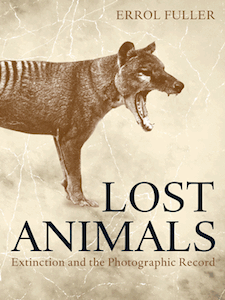If ever a book embodied the truth behind the old saying that a picture is worth a thousand words it is Errol Fuller’s new Lost Animals; Extinction and the Photographic Record, for while somewhat sparing in text, the photographs it includes speak volumes. Indeed, it might even be said that the light touch given to the amount of text included allows the stories of the animals to be told all the more effectively by the photographs themselves.
Many readers will no doubt already be familiar with Mr. Fuller’s work conveying the fascinating stories of many of the planet’s vanished creatures in such previous of his books as Extinct Birds, Dodo: From Extinction to Icon, and The Great Auk. Combining his talents as both a writer as well as an artist, Mr. Fuller has a particular knack for using imagery to the greatest effect in recounting the life histories of his subjects in order that his readers may come away from his books with a sense of just what has been lost. However in Lost Animals, he may have exceeded even his own previously set high standards.
Rather than focusing exclusively on the natural histories of the animals themselves (of which three-fourths included in the book are birds), Mr. Fuller brings in the history of their respective photographic records as well. Naturally, this limits his time frame to that of photographic history – roughly from the mid-point of the Nineteenth Century up to our present day – and precludes such species as the aforementioned Dodo or Great Auk from being included (as he poignantly notes, the last two of the latter species were killed around the same time as one of the first photographic books of wildlife imagery was being published).
Indeed, it is Mr. Fuller’s presentation of the histories of the photographs that adds a wholly unexpected dimension to the respective stories of the extinction of the species included. In many cases, the photos are old, grainy, black and white images recorded using heavy, cumbersome cameras under what must have been exceptionally difficult conditions. That they were recorded at all and that those included in the book still exist as the sole reminder of the fact that the animal depicted ever existed cannot help but to leave the reader contemplating just what an astonishing thing extinction is. For had such a singular image of, for example, the Alaotra Grebe, not been recorded and preserved, not only its own existence but the very memory of its existence may very well now be lost.
Lost Animals is not a book to read cover to cover in one sitting; it should be read one species at a time with plenty of attention and contemplation given to the remarkable photographs of each one. In this way, each species – regardless of how grainy or out-of-focus the image may be – will become all the more real and its disappearance from this planet far more significant than if it had only been seen in a painting. Fine paintings can move our emotions, but photographs, freezing moments of time in reality as they do, have the power to demand that we confront the very ideas of existence and extinction themselves. Mr. Fuller clearly knows this, and after reading his Lost Animals, you will as well.
 Title: Lost Animals; Extinction and the Photographic Record
Title: Lost Animals; Extinction and the Photographic Record
Author: Errol Fuller
Publisher: Princeton University Press
Format: clothbound
Pages: 240
ISBN: 9780691161372
Publication Date: 2014
In accordance with Federal Trade Commission 16 CFR Part 255, it is disclosed that the copy of the book read in order to produce this review was provided gratis to the reviewer by the publisher.
This review was originally published in the July / August 2014 issue of Bird Watcher’s Digest.
